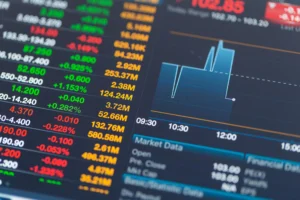Are you tired of second-guessing market moves and following price alone? The real edge in modern trading often hides in volume. The Trade Volume Index brings this hidden force to light, helping traders make better decisions by combining price action with real trade volume. If you want to finally cut through the noise and see what’s really driving markets—whether you trade forex, stocks, crypto, or futures—understanding the Trade Volume Index could transform your approach.
This guide reveals what makes the Trade Volume Index different, how the TVI formula works, how to calculate the Trade Volume Index by hand or with software, and most importantly, how you can use this volume-based technical indicator for consistent, smarter trades. You’ll get practical examples, advanced use cases, and actionable tips you won’t find in basic trading guides.
What is the Trade Volume Index?
The Trade Volume Index is not just another line on your chart. Think of it as a live meter of market conviction. It tracks whether real money is flowing into (or out of) a market as prices change. Unlike most indicators that respond to price alone, the Trade Volume Index adds a crucial layer: trade volume. It tells you whether buyers and sellers are “voting with their wallets,” not just moving prices with small orders.
Traditional price-only strategies miss this. Sometimes prices wiggle up and down with no real conviction. Other times, a powerful move happens, but if there’s no real volume behind it, that move can fizzle fast. The Trade Volume Index gives you a behind-the-scenes look at what’s truly happening, not just what’s visible on the price chart.
Why Volume-Based Technical Indicators Matter
Many beginners overlook volume. They see the price rising and assume it will continue. But savvy traders know that without significant volume, moves are weak and short-lived. Volume-based technical indicators like the Trade Volume Index are designed to answer a simple but vital question: “Is this price move real or just noise?”
If you want to filter out the fakes and spot the genuine, understanding the Trade Volume Index is a must.
The TVI Formula: Understanding How It Works
Let’s get to the heart of it. The TVI formula is both simple and powerful. It works by evaluating each price change with its corresponding volume. Here’s how:
- If the price rises by more than a set threshold (for example, 0.01 in forex), add the period’s volume to the previous TVI.
- If the price drops by more than that negative threshold, subtract the volume from the previous TVI.
- If the price change is smaller than the threshold in either direction, leave the TVI unchanged.
This way, you only count the moves that actually matter, not the tiny up-and-down wiggles that clutter most charts.
The Formula in Action
Suppose you’re analysing the EURUSD:
- At 10:00 AM, the price is 1.1000, and the TVI is at 0.
- At 10:01, the price moves to 1.1003 (up 0.0003), and the volume is 100.
- Since the price moved up more than your threshold (say, 0.0001), you add 100.
- New TVI = 0 + 100 = 100
- At 10:02, the price drops to 1.1000 (down 0.0003), and the volume is 80.
- Since the price dropped beyond the negative threshold, subtract 80.
- New TVI = 100 – 80 = 20
- At 10:03, the price ticks up to 1.1001 (up 0.0001), but your threshold is 0.0002, so you do nothing.
- New TVI = 20
The Trade Volume Index therefore only responds to meaningful price-and-volume changes, giving you a much clearer read on the real pressure in the market.
How to Calculate Trade Volume Index: Step-by-Step Guide
Calculating the Trade Volume Index by hand is easy, and understanding the calculation will help you use it better, even when your trading platform does it for you.
Step 1: Set Your Threshold
Choose a value that filters out market “noise.” For most forex pairs, a threshold of 0.0001 to 0.0005 works. For stocks, something like $0.01 or $0.05 is common.
Step 2: Start Your Calculation
Begin with TVI = 0. (You can start from any value, but zero keeps things simple.)
Step 3: Move Through Your Data
For each new bar or tick:
- If the current price minus the previous price is greater than the threshold, add volume.
- If the current price minus the previous price is less than -threshold, subtract volume.
- If the change is within the threshold, do nothing.
Step 4: Repeat
Update for every new data point.
Example:
Let’s use a simple stock scenario:
| Time | Price | Volume | TVI Calculation | TVI |
|---|---|---|---|---|
| 9:30 | $20.00 | 1,000 | Start | 0 |
| 9:31 | $20.02 | 1,200 | $20.02 – $20.00 = $0.02 > 0.01, add 1200 | 1,200 |
| 9:32 | $20.01 | 800 | $20.01 – $20.02 = -$0.01 < -0.01? No, within threshold | 1,200 |
| 9:33 | $20.05 | 1,500 | $20.05 – $20.01 = $0.04 > 0.01, add 1500 | 2,700 |
| 9:34 | $20.03 | 900 | $20.03 – $20.05 = -$0.02 < -0.01, subtract 900 |
So, at each step, you can see the Trade Volume Index rising on genuine bullish action, staying flat during noise, and dropping only when a real bearish move is confirmed with volume.
Why the Trade Volume Index Works: Going Beyond Price
Most technical traders obsess over price action. But the real story is often told in the background. If you see a big green candle but the Trade Volume Index does not rise, be careful. That move might not last. On the other hand, when you see both price and TVI rising in sync, you’ve got solid confirmation.
Volume-based technical indicators, especially the Trade Volume Index, are your shortcut to reading market psychology. You’re not just watching what the market does, but how much conviction stands behind each move.
Example: Fakeout vs. Breakout
Suppose Bitcoin suddenly jumps by $200 in five minutes. Exciting, right? But if you check the Trade Volume Index and it barely budges, there’s no real volume behind the move. This is often a fakeout—maybe a few large orders, not a true trend.
Next day, Bitcoin rises by another $200, and this time the TVI also jumps significantly. Now, you know real buyers are entering. That’s the kind of move that is more likely to last—and one you want to ride.
How to Use Trade Volume Index for Smarter Trades
Now let’s put this knowledge into action. Here are practical ways to use TVI and trade volume analysis in your everyday trading.
1. Confirming Breakouts
Breakouts are thrilling—but not all of them are real. Before you chase a breakout, check the TVI. If it’s rising with price, chances are the breakout will hold. If not, the move is likely to fail.
For example, say EURUSD breaks above resistance. If the Trade Volume Index also climbs, jump in. If the TVI is flat, hold back.
2. Spotting Trend Reversals
Divergence between price and the Trade Volume Index is a classic reversal signal.
Suppose price keeps climbing, but TVI starts to flatten or fall. This hints that the upward move is losing momentum.
Likewise, if price falls but TVI starts to rise, buyers are quietly stepping in and a reversal could be near.
3. Filtering Out Market Noise
Many traders lose money chasing every minor move. The Trade Volume Index helps you focus on what matters. If TVI is flat, there’s no real buying or selling happening—so why risk it? Wait for a clear TVI signal before entering trades.
4. Combining TVI With Chart Patterns
Volume-based technical indicators are powerful alone, but paired with patterns, they are even better.
- Head and Shoulders: If the neckline breaks and TVI surges, the move is for real.
- Double Bottoms: Wait for TVI to confirm the breakout with strong volume.
5. Intraday and Scalping Use
Scalpers love TVI for one simple reason—it works fast. If you trade on 1-minute or 5-minute charts, TVI shows you where volume is entering right now. This helps you catch quick moves and avoid being stuck in slow markets.
Advantages of Trade Volume Index Over Other Volume Indicators
The TVI is unique compared to basic volume bars or on-balance volume. It only reacts when a real price move happens, ignoring sideways chop.
Unlike indicators that sum volume blindly, TVI attaches volume only to meaningful price moves. This helps you avoid false positives and keeps your signals clean.
Limitations and Tips for Getting the Most From TVI
No tool is perfect, and the Trade Volume Index is no exception.
Limitations:
- In markets with unreliable or low volume data (some crypto pairs, penny stocks), TVI can lag or mislead.
- Very short timeframes (1 tick, 5 seconds) may have erratic readings.
- TVI does not predict the future—it just shows real conviction behind current moves.
Tips:
- Always use TVI alongside price action and at least one other volume-based technical indicator.
- Adjust your threshold for different markets and timeframes. Backtest for best results.
- Look for TVI confirmation during important news events. Volume often spikes and TVI gives extra clarity.
Trade Volume Index vs. Other Volume-Based Technical Indicators
You might ask: Why not just use On-Balance Volume (OBV), Chaikin Money Flow, or standard volume bars?
TVI stands out because:
- It only tracks volume for significant price moves, reducing noise.
- It is easy to read: Up means buyers dominate, down means sellers.
- It provides cumulative insight—making it easier to spot big-picture changes in sentiment.
Combining TVI with other volume-based technical indicators like Accumulation/Distribution or Money Flow Index gives even more power to your analysis.
Advanced Trade Volume Analysis: Real-World Scenarios
Case Study 1: Trading Gold Futures
Gold prices often “fake” breakouts during news. Suppose price surges on headlines. You check the Trade Volume Index. If TVI confirms the move with strong volume, you can ride the trend with more confidence. If TVI is weak, it’s safer to skip the trade.
Case Study 2: Crypto Bull Runs
When Bitcoin or Ethereum make big moves, TVI is your best friend. During the 2021 crypto bull run, major rallies in ETH often showed TVI surging well before the price made headlines. Spotting that early TVI surge gave savvy traders a jump on the crowd.
Case Study 3: Forex News Trading
Non-farm payrolls release causes EURUSD to spike. Price jumps up fast, but TVI does not rise. Experienced traders wait for the next bar. If TVI finally jumps, they enter—often catching the real move before retail traders catch on.
FAQ on Trade Volume Index
Q: Can I use TVI for swing trading?
A: Absolutely. TVI works on all timeframes, though the threshold may need adjustment. It is especially valuable for swing traders confirming trends.
Q: Is TVI good for penny stocks?
A: It can be, but beware of unreliable volume data in illiquid markets.
Q: Should I trade on TVI alone?
A: Use it as confirmation, not your only signal. Pair with other indicators and price action.
Final Word
In fast-moving markets, speed and clarity matter. The Trade Volume Index gives you both. By measuring price moves only when real money is at work, TVI helps you cut through the hype and focus on what truly matters: conviction.
Add the TVI formula to your charts, practice reading its signals, and soon you’ll spot the difference between fake moves and real trends. The more you use volume-based technical indicators like TVI, the more confident and consistent your trading becomes.
Smarter trades start with smarter analysis. The Trade Volume Index gives you the edge you need, no matter your trading style or market.
Read here to learn more about “Pivot Points Trading Strategy for Reliable Trade Entries and Exits“.

I’m Chaitali Sethi — a seasoned financial writer and strategist specializing in Forex trading, market behavior, and trader psychology. With a deep understanding of global markets and economic trends, I simplify complex financial concepts into clear, actionable insights that empower traders at every level. Whether it’s dissecting winning strategies, breaking down market sentiment, or helping traders build the right mindset, my content bridges the gap between information and implementation.

